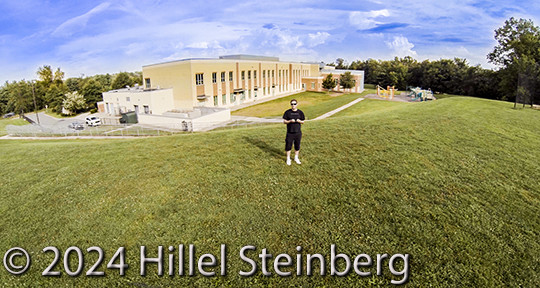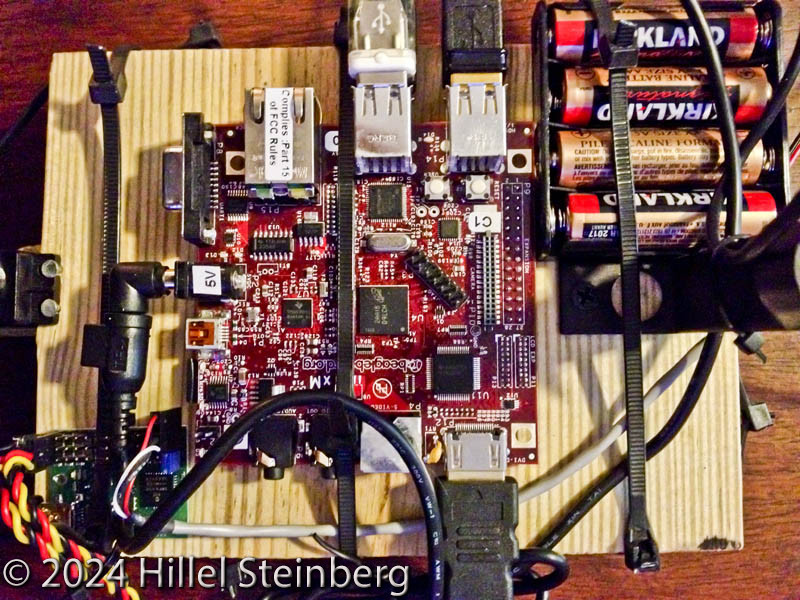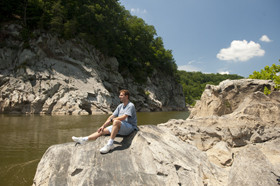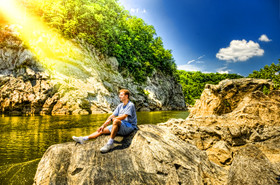Jan
11
2014
By Hillel

Over a decade ago, I bought an electric plane and took it to a field near my work. After a few minutes of flying it, the foam structure was sitting on the grass in cute little pieces. Though I could have glued the model together again, I concluded instead that the technology simply wasn’t there yet to make this an enjoyable hobby. In the mid-90s, flying RC platforms were expensive, had short-lived flight times, had limited range, rarely utilized modern technologies (e.g. GPS) and still/video/FPV (first-person-view) recording was fantasy for the average hobbyist. In the decade that followed, I launched rockets with cameras on them, and transmitted live video from RC trucks in my living room. But, my thoughts always came back to RC flying platforms, and their ability to get photos from new and exciting vantage points.
(more»)
- Tags:
- Aerial,
- Blade 350 QX,
- Drone,
- Fly,
- GoPro,
- Hobby,
- Landscape,
- photography,
- Platform,
- Quadcopter,
- RC,
- Technology
Aug
10
2013
By Hillel

I’ve always been interested in RC devices. In particular, I’ve often been curious about platforms that fly. About twenty years ago I purchased an electric white plane at a hobby shop across the street from my work, but it didn’t last very long. The technology at the time was both expensive and limited – not an exciting combination. Today, there are a menagerie of flying solutions, including the very stable and affordable quadrocopter drones. The geeky “heli” hobbyists will scoff at these platforms, but the truth is they are perfect if you are interested in immersive photography like I am. To tangle with this hobby, though, several steps and some cash are required.
The first thing to do is visualize your end goal. In my particular case, I’m interested in an HMD (Head Mounted Display) with an FPV (first-person-view) from the platform’s perspective of about 30+ meters. While it’s true that one could simply buy all the parts required and jump right in, a better way to achieve this goal is to break the problem down into measurable steps. This will minimize your risk, and set you up for success. For this goal, I have broken the problem above into at least four steps.
As your first step, you can buy a cheap used quadrocopter and practice with it so you understand this particular platform’s flight characteristics and considerations. I bought a used Parrot AR (first version) for $60 off Craigslist to get started. It came with a second battery which is a plus and I would highly recommend this if you are just getting started. These RC platforms often use lithium polymer batteries which can be dangerous and explode, so follow the directions closely, and only use the correct charger and batteries (e.g. no trickle charging!). Take the quadrocopter out to a field so you have a softer landing if you screw up – and you will. Make sure on your first few times that you have plenty of room and there is no wind or strong breeze. Before you take off, make sure you know exactly how to force a landing should you need to abort an oncoming disaster. Because this is presumably a cheaper device, range will be a restriction so keep the platform close and only make small movements with your controller.
(more»)
- Comments Off on Aerial Photography – A Study in Higher Education
Feb
09
2013
By Hillel

Note: This post isn’t about photography per se, but I came up with many other uses for my Pis, so I couldn’t help it 😉
I know plenty about hardware, but I’m really a software guy at heart. If there is a way to do something in software, it’s usually cheaper, easy to duplicate for others, more flexible once deployed, and more adaptable in the long run. Which brings me to Pandora. I like the idea of Pandora (nearly commercial free radio based on a desired theme), but there are several problems with it. Some things I can’t do anything about, and it won’t really change. Pandora has a limited selection when it comes to certain themes. Hint: Type in Billy Crystal to get Pandora going. But, when a channel works, you often don’t want to reserve real estate on your computer, or resources on your phone while it’s in operation. In fact, you often want one without the other. Enter the Raspberry Pi.
This weekend I took one of my unused Raspberry Pi’s (I have at least five floating around!), and upgraded it’s copy of pianobar software to listen to Pandora using the output jack and a portable battery powered speaker. I noticed that pianobar supports a shared file mechanism to adjust channels, volume, and other aspects of play. I set the Raspberry Pi up in the corner with a battery pack-to-USB adapter I created which offers approximately four hours of continuous operation for the Pi. I added a portable rechargeable speaker system that can be plugged into the Pi’s audio output jack.
For a while, SSH worked well to control pianobar remotely. The Pi is wireless and can be used anywhere in the house. Because the power pack is mobile, and the audio outputs are self powered, the system is quite portable. The problem is control. Let’s say I want to bring the Pi downstairs so I can listen to some soundtracks while I eat lunch. I can’t easily change the channels, lower the volume, or pause the music. Sure, I could get an SSH app for my iPhone, but that’s not as easy to use as I’d like. I could also build various buttons on a breadboard hooked to the Pi, but then the system will be harder to duplicate, diagnose issues, and can’t be operated remotely. Finally, my kids aren’t going to be using SSH, so I need to a better control mechanism.
(more»)
Apr
15
2012
By Hillel

So Google didn’t hire you, but you still want to do cool things like engineer a miniature device to capture indoor 360 degree panoramas. Not to worry. The key to reaching this challenge lies in the art of breaking down goals into manageable pieces. You’ll need to build these pieces separately and then integrate. Finally, you can iterate your results stepwise toward perfection. While your device is short of perfection, however, you should probably call your progress “Beta”.
First, you’ll need a small computer platform to do the work on. This platform needs to be mobile so size is key. It will need to be powered by a portable battery source, and provide a wireless connection for access from your mobile device (e.g. phone). An Arduino, BeagleBoard, or Rasberry PI will do. For the purposes of this entry, I’ll just use the BeagleBoard TI ARM Cortex platform because, at the time of writing, it is currently the most capable and accessible of the three.
(more»)
- Comments Off on DIY Miniature Panorama Collection System
- Tags:
- BeagleBoard,
- C++,
- Control,
- Embedded,
- Linux,
- Maestro,
- Pan,
- panorama,
- Servo,
- ServoCity,
- Tilt,
- Ubuntu,
- USB,
- WIFI
Dec
27
2011
By Hillel

In July of this year (2011), my family took a comprehensive trip to Israel for the grand tour. We hit all the major highlights, and everyone had a blast. I shlepped my Nikon D700 on the trip, and several lenses to cover possibilities. By the flight home, I had taken over 20,000 photos from the southern resort of Eilat, to the Golan Heights in the north.
Many of the photos were actually series. Some series were collected to make sure a particular event was not missed. Some series were performed as bracketed shots which could be later combined to synthesize HDR composites. Other series were bracketed simply to provide a palette of exposure options to choose from later – and thus insurance when capturing a photo opportunity. Still other series were collected for the ultimate purpose of generating stitched panoramas.
Read More »
- Tags:
- Boat,
- City,
- Coastline,
- D700,
- Israel,
- Jaffa,
- Long,
- nikon,
- panorama,
- Port,
- Shore,
- Stitch,
- Tel-Aviv,
- trip,
- Yaffo
Aug
26
2011
By Hillel

It’s natural for a father to want to share his passion for hobbies with offspring. My father tried endlessly to introduce each of his three kids to the philatelic world, but could not find a single taker among them. To this very day, he is continues to fill out duplicate albums in the hopes that one day, as if by sudden inspiration, his kids will wake up and fulfill his lifetime dream. Still, when it finally dawns on you that your kid’s interests may never intersect yours, there’s always… well there’s always your nephew!

For as long as I can remember, I’ve always had hobbies, but computers, photography, and guitar have always placed at the very top. For example, I was one of the first kids in my high-school class to own and program a personal computer at a time when most had never heard of these world-changing machines. This path eventually led to an entire career in 3D software development.
Read More »
- Tags:
- 3D,
- Alexander,
- Billly Goat,
- Camp,
- Computers,
- Geek,
- Guitar,
- Hillel,
- Jonesi,
- Longwood,
- Music,
- panorama,
- Passion,
- photography,
- Steinberg,
- Summer,
- Washington
Mar
20
2011
By Hillel


I’m often asked to take pictures for a special event. At some point later, I’m requested politely to just send the pictures to an email address “when I can”. I don’t have a quick answer for this, so I’m writing this BLOG entry to address what looks like a straight-forward request… but isn’t. The short answer is that there is much more to professional shooting than most think. For this discussion, I’m going to assume “Frank” is asking for the pictures. Below is a summary of the reasons why Frank will probably not get the pictures in an email. Let’s begin.
Read More »
- Tags:
- art,
- bridge,
- calibration,
- camera raw,
- frank,
- Hillel,
- lossy,
- nikon,
- photography,
- photoshop,
- professional,
- spyder elite,
- Steinberg,
- steps,
- technique,
- workflow
Dec
20
2010
By Hillel

Figuring out your next photography quest is like picking a good restaurant. You don’t want to eat at the same joint frequently because you will likely find it boring over time. You don’t want to pick a restaurant randomly because the odds of the place having food you like, a comfortable setting, and reasonable prices is low and ultimately risky. Recommendations from friends are a good start, but even then, tastes vary. Critiques can’t be relied on either. A friend may rave about a place, and you might then decide on a whim to go and try it out. After your little experiment, you’re left wondering if you came to the wrong place, the friend was simply distracted by a waitress, or they were paid handsomely for their recommendation.
Read More »
- Tags:
- bald,
- BLOG,
- conowingo,
- dam,
- Eagle Photography workshop trip maryland dam conowingo,
- eagles,
- elk,
- fish,
- Hillel,
- lighthouse,
- neck,
- panorama,
- park,
- photography,
- river,
- Steinberg,
- susquehanna,
- trip,
- tripod
Oct
31
2010
By Hillel

I’ve always loved science. From an early age, my father fostered this interest by exposing me to many of the branches of science through a variety of activities, experiments, and mini-lectures. Though he didn’t have the same knack as Bill Nye, Neil deGrasse Tyson, and Stephen Hawking for distilling complex theories into digestible concepts, he did continuously spark my interest in the sciences. Throughout my childhood, my father exhibited frequent bouts of scientific curiosity, and was always steadfast in his confidence in the scientific method. Without explicitly spelling it out, he made it clear that it was not faith, but this singular method that can be trusted to make sense of the world around us – and for the most part, already has for me.
At an early age, my father and I put together a large mirror-based telescope with an electric motor to track the stars, and he taught me how to align the base of it towards the North Star for proper tracking. We manually located various celestial objects including the moon, various planets, and even some popular star clusters. By observation, it was clear that there was a huge disparity in distance between the near planets and the almost unimaginable distant stars. Both planets and stars looked about the same size with out eyes, but in the telescope, planets grew, but stars remained mere pinpoints of light. Space was obviously grand on a scale almost unimaginable to me. I learned the difference between solar and lunar eclipses in February of 1979 during a rare total solar eclipse when my dad took us out on the back patio to witness it. Though I wasn’t allowed to look at it directly, just the fact that this event could be predicted by astronomical study made an impact on me. Though his information wasn’t always reliable, his enthusiasm was guaranteed as he fielded many of my questions about the sky and beyond. Later I would take an introduction Astronomy course at the University of Maryland and fill in many of the missing gaps that I had either failed to ask or understand.
Read More »
- Tags:
- 2010,
- Bill,
- Engineering,
- Father,
- Festival,
- Guy,
- Harold,
- Hillel Steinberg,
- Nye,
- Science,
- Steinberg
Mar
09
2010
By Hillel

Everyone loves a good Bar Mitzvah party. Kids and adults are everywhere, running, eating, singing, and dancing – many choosing to do more than one of these activities at the same time. Those not dancing in the dim and flashing lights can be found twisting in pink glowing hula-hoops. As the kids finish wrapping their friends in toilet paper, they parade across the floor in conga lines while the adults lift the honored family high in flimsy chairs.
It is exactly for these reasons that photographing a Bar/Bat Mitzvah party is as tricky as landing a rover on Mars. Lighting, motion, and depth are key elements to the camera and photographer. When there is good lighting, negligible motion, and minimal depth, your four year old niece can take the shot with a cheap point-n-shoot with good results. When the lights are dim, everyone is running around like a sale at Macy’s, and there’s action at every distance, you need to prepare like an astronaut or your pictures will look like… well… like a four year old took them.
Read More »
- Tags:
- Bar Mitzvah,
- Bat Mitzvah,
- camera,
- event,
- Flash,
- Hillel,
- Jewish,
- party,
- Photography Events,
- settings,
- simcha,
- Steinberg,
- technique












